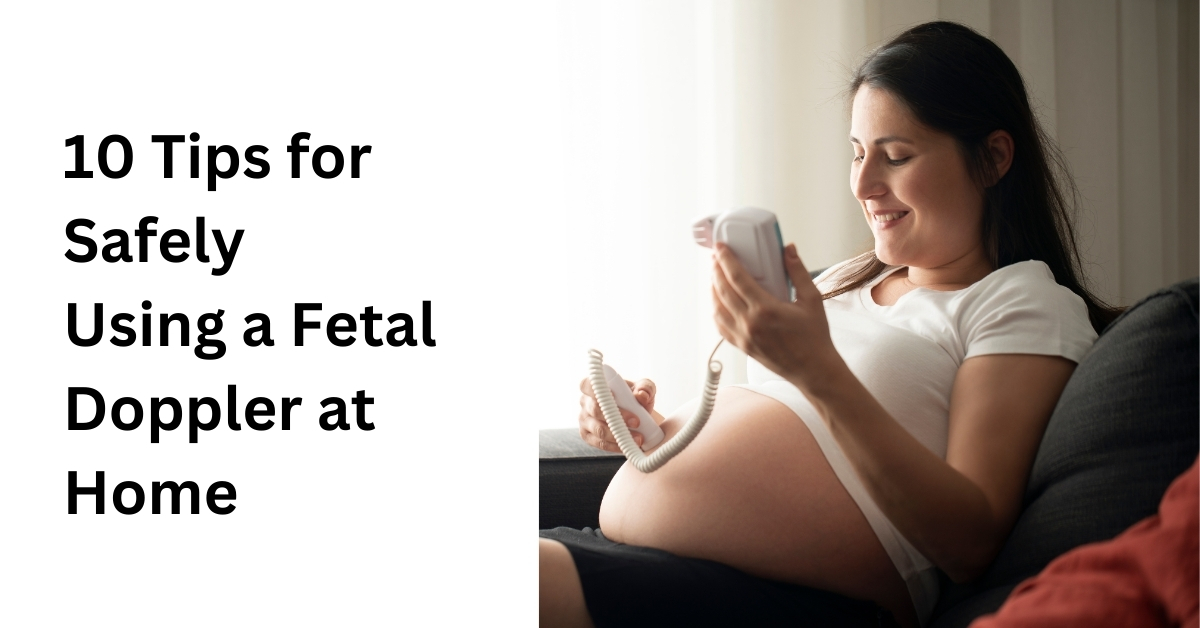Currently Empty: $0.00
10 Tips for Safely Using a Fetal Doppler at Home

Pregnancy is a time filled with excitement, anticipation, and sometimes a touch of anxiety. For many expectant parents, hearing the sound of their baby’s heartbeat is a moment of pure joy and reassurance. Thanks to advancements in technology, this experience can now be enjoyed from the comfort of home with the use of a fetal doppler. However, it’s essential to use this device safely and effectively to avoid any unnecessary risks or concerns. In this blog, we’ll explore what a fetal doppler is, along with ten tips for safely using it at home.
What is a Fetal Doppler?
A fetal doppler is a handheld ultrasound device used to detect the heartbeat of a fetus as early as 8-12 weeks into pregnancy. It works by emitting high-frequency sound waves that bounce off the fetal heart, producing an audible sound that can be heard through the device’s speaker or headphones. Fetal dopplers are widely available for home use, offering expectant parents the opportunity to bond with their baby and monitor their heartbeat between doctor’s appointments.
Tips to Use a Fetal Doppler at Home:
1. Consult with Your Healthcare Provider
Before using a fetal doppler at home, it’s crucial to consult with your healthcare provider. They can provide guidance on when and how often it’s safe to use the device based on your individual circumstances. Additionally, they can offer tips for proper technique and interpretation of the fetal heartbeat.
2. Choose the Right Device
Selecting a high-quality fetal doppler is essential for accurate and reliable results. Look for a device that is FDA-approved and recommended by healthcare professionals. While there are many options available on the market, it’s important to choose one from a reputable manufacturer with positive reviews.
3. Use Ultrasound Gel
Before using the fetal doppler, apply a generous amount of ultrasound gel to your abdomen. This gel helps to improve conductivity and ensures that the sound waves can penetrate the skin more effectively, resulting in clearer and more accurate readings.
4. Find a Comfortable Position
Lie down on your back or recline in a comfortable position before using the fetal doppler. This will help to relax your abdominal muscles and make it easier to locate the baby’s heartbeat. You may also consider propping a pillow under your knees for added support.
5. Listen for the Heartbeat
Once you’ve located the baby’s heartbeat, listen carefully for the distinctive sound. The fetal heartbeat is typically described as a rapid whooshing or galloping sound, similar to the sound of a horse trotting. Pay attention to the rate and rhythm of the heartbeat, as these can provide valuable insights into your baby’s health and development.
6. Avoid Excessive Use
While it can be tempting to use the fetal doppler frequently to check on your baby, it’s important to avoid excessive use. Limit your sessions to no more than once per day for a few minutes at a time. Overuse of the doppler can potentially expose the fetus to unnecessary ultrasound waves, although there is no conclusive evidence of harm from occasional use.
7. Start Low and Slow
Begin by placing the fetal doppler low on your abdomen, just above the pubic bone. Move the device slowly and gently in a circular motion until you hear the heartbeat. It may take some time to locate the heartbeat, especially in the early stages of pregnancy, so be patient and persistent.
8. Be Patient and Persistent
Finding the fetal heartbeat with a doppler can sometimes be challenging, especially in the early stages of pregnancy or if the baby is in a difficult position. Don’t be discouraged if you can’t find the heartbeat right away. Take breaks as needed, reapply gel, and try again later. If you’re unable to locate the heartbeat after several attempts, contact your healthcare provider for further guidance.
9. Know When to Seek Help
While using a fetal doppler at home can provide reassurance for expectant parents, it’s essential to recognize its limitations. If you have any concerns about your baby’s health or well-being, don’t hesitate to contact your healthcare provider. They can perform a thorough assessment and provide appropriate care and guidance based on your individual needs.
10. Enjoy the Experience
Finally, remember to cherish the moments spent bonding with your baby through the use of a fetal doppler. Hearing their heartbeat for the first time or feeling their movements can be incredibly special and memorable experiences. Take the time to savor these moments and celebrate the miracle of new life.
In Conclusion
Using a fetal doppler at home can be a rewarding and reassuring experience for expectant parents, allowing them to connect with their baby in a unique and meaningful way. By following these ten tips for safe and effective use, you can enjoy the benefits of fetal doppler monitoring while minimizing any potential risks or concerns. Remember to consult with your healthcare provider for personalized guidance and support throughout your pregnancy journey.














